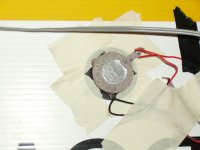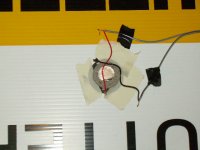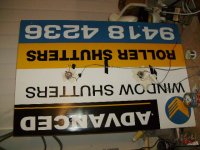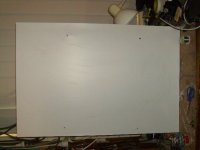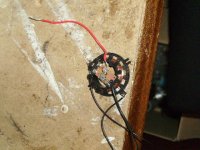Have been mucking around with a couple of old Motorola piezo elements(dismantled from their casings) - piezo actuator disk and small cone only.
Stuck the small black cones with thin strips pf packing tape to the back of a thin corrugated cardboard panel: 18 inches x 12 inches approximately. Used a small matching transformer from some old Le Son piezo tweeters.
Wow! was I surprised! on their own in free air sound was reasonable loud but not very ''full sounding''. When stuck to the panel, the sound became louder and deeper. Still needs a woofer to fill in the gap, but I was amazed at the dipole like panel sound that reminded me of the NXT panels I have played around with.
on their own in free air sound was reasonable loud but not very ''full sounding''. When stuck to the panel, the sound became louder and deeper. Still needs a woofer to fill in the gap, but I was amazed at the dipole like panel sound that reminded me of the NXT panels I have played around with.
These panels however, produce MUCH MORE high frequencies with lightening speed - and that's just crappy old cardboard Is this some form of distributed mode thingy happening or what?
Is this some form of distributed mode thingy happening or what?
Perhaps worth some further investigation as piezo elements are not expensive and relatively east to find in various types and forms??
Will try some much larger thin poly. foam sheet to see what happens.
Stuck the small black cones with thin strips pf packing tape to the back of a thin corrugated cardboard panel: 18 inches x 12 inches approximately. Used a small matching transformer from some old Le Son piezo tweeters.
Wow! was I surprised!
These panels however, produce MUCH MORE high frequencies with lightening speed - and that's just crappy old cardboard
 Is this some form of distributed mode thingy happening or what?
Is this some form of distributed mode thingy happening or what? Perhaps worth some further investigation as piezo elements are not expensive and relatively east to find in various types and forms??
Will try some much larger thin poly. foam sheet to see what happens.
The two piezos are now mounted on a 3mm thick piece of MDF (medium density fibre board : dry wall in U.S ?) 3.5 feet X 2.5 feet. Sound has gotten much louder and deeper again. The high frequencies are still very much audible but I suspect that this is due to the rear radiation of the piezos.
From the front you can tell that the whole board is resonating as one large panel with louder sections where the piezos are mounted from behind.
There does not seem to be the typical ''piezo sound'' that we all know. Perhaps because the transducers are not horn loaded and encased in plastic?
I think there is some potential to this NXT type of implementation providing you have the impedence matching transformer which increases volume dramatically.
Anyone care to comment ??
From the front you can tell that the whole board is resonating as one large panel with louder sections where the piezos are mounted from behind.
There does not seem to be the typical ''piezo sound'' that we all know. Perhaps because the transducers are not horn loaded and encased in plastic?
I think there is some potential to this NXT type of implementation providing you have the impedence matching transformer which increases volume dramatically.
Anyone care to comment ??
Changed to ''CORE FLUTE'' (corrugated plastic laminate) of around 5mm, 3 foot X 2 foot.
Man, now we're talkin.........two piezo tweeters create this much sound?.........and go this low? You can just feel the entire panel vibrate on voice and guitar/drums.
For those who have frowned upon the idea of NXT panels(including myself), I'm beginning to see where the advantages are : obviously this is only an upper mid(??)/tweeter range, but percussion, piano, guitar sounds AWESOME
Man, now we're talkin.........two piezo tweeters create this much sound?.........and go this low? You can just feel the entire panel vibrate on voice and guitar/drums.
For those who have frowned upon the idea of NXT panels(including myself), I'm beginning to see where the advantages are : obviously this is only an upper mid(??)/tweeter range, but percussion, piano, guitar sounds AWESOME

231 views and NO COMMENTS?????...........looks like no one is taking this seriously.
Oh well, at home I have a working DISTRIBUTED MODE ACTUATOR PANEL of monsterous proportions producing sounds that I would not think were possible from a couple of transformer coupled , stripped down piezo drivers.
I have some NXT moving coil exciters on their way and will try to incorporate both methods(piexo + NXT) of panel excitation to compensate for the high frequencies loss of the NXT driver.
The prototype panel will be a large one - 6 foot x 2 foot with two NXT drivers per side plus a piezo on the front or rear depending on what the performance is like.
I have access to many different panels and have researched the NXT principles of sound reproduction for a few months now.
I know others have tried to implement these exciters without success, but I have a few aces up my sleeve on this one.
We'll see what happens..........if anyone cares that is

Oh well, at home I have a working DISTRIBUTED MODE ACTUATOR PANEL of monsterous proportions producing sounds that I would not think were possible from a couple of transformer coupled , stripped down piezo drivers.
I have some NXT moving coil exciters on their way and will try to incorporate both methods(piexo + NXT) of panel excitation to compensate for the high frequencies loss of the NXT driver.
The prototype panel will be a large one - 6 foot x 2 foot with two NXT drivers per side plus a piezo on the front or rear depending on what the performance is like.
I have access to many different panels and have researched the NXT principles of sound reproduction for a few months now.
I know others have tried to implement these exciters without success, but I have a few aces up my sleeve on this one.
We'll see what happens..........if anyone cares that is

I've played around with moving coil exciters. After the initial excitement of experimentation wore off I came to the conclusion it's nothing more than a noise making novelty.
It's interesting you find Corflute to sound good as this was the worst sounding panel material I tried; second worse being foam core. Surprisingly the best thing I tried was some good old stiff corrugated cardboard.
It's interesting you find Corflute to sound good as this was the worst sounding panel material I tried; second worse being foam core. Surprisingly the best thing I tried was some good old stiff corrugated cardboard.
Do you have any pics for each of the above to show what
you were doing as these evolved? That way it may be easier
to see what you did and anybody with the old piezos can
also experiment. I had several of those that I took apart
and played with about 25 years ago, but I think I eventually
blew all of them!
you were doing as these evolved? That way it may be easier
to see what you did and anybody with the old piezos can
also experiment. I had several of those that I took apart
and played with about 25 years ago, but I think I eventually
blew all of them!
At last some replies !!!
I'll try again to post some pictures. May need to compress the images as my last attempt failed.
I think that the coreflute sounds best so far because It is so large compared to everything else I've tried.
I agree that corrugated cardboard seemed to be much louder in a small piece. Wonder how it will go in a giant size?
Damosan, let me get a large size piece of board First and I'll get you to come around and here this princile in operation.
I'll try again to post some pictures. May need to compress the images as my last attempt failed.
I think that the coreflute sounds best so far because It is so large compared to everything else I've tried.
I agree that corrugated cardboard seemed to be much louder in a small piece. Wonder how it will go in a giant size?
Damosan, let me get a large size piece of board First and I'll get you to come around and here this princile in operation.
Interesting stuff Ziggy,
Do you have any means of making measurements? I must admit to having immediately dismissed NXT and anything resembling it directly to the "dustbin" without a moment's consideration! However, I find the planar & alternative technologies section of this forum to be the most interesting of all. People really are "thinking outside the box" if you'll pardon the pun.
Keep up the investigations!
Cheers,
Ed
Do you have any means of making measurements? I must admit to having immediately dismissed NXT and anything resembling it directly to the "dustbin" without a moment's consideration! However, I find the planar & alternative technologies section of this forum to be the most interesting of all. People really are "thinking outside the box" if you'll pardon the pun.
Keep up the investigations!
Cheers,
Ed
The Anonymous1, sorry to hear that you had little success with your NXT experiments.
Were you aware at the time that these exciters work best on ''floating panels''? Were you also aware that by using multiple exciters per panel brings you in to another dimension of possibilities and sound quality? Plus, what size panel were you experimenting on? if it was of small or medium size, you will have limited the bandwidth to just that size. A large panel 6 foot X 2 foot will be a different ball game for certain.
You speak of corrugated cardboard as the best sound you obtained. There are many coatings that can be applied to this : dope used in model aircraft for example will strengthen the cardboard significantly without adding too much more mass. However, what it will also do is BRIDGE the front and back laminates through the corrugation enabling a much more efficient transfer of energy(IN PARTICULAR THOSE BLOODY HIGH FREQUENCIES THAT ARE LOST THROUGH THE TRANSMISSION OF VIBRATIONS WITH OTHER MATERIALS SUCH AS FOAM CORE, COREFLUTE AND RELATED ''SOFT'' MATERIALS).
Even plain thin foam can be epoxy coated and hardened with a special type designed primarily for foam!
Reading up on Shelly Katz's PODIUM LOUDSPEAKERS, he reveals that the panel material's best and most appropriate quality is that it ''rings like a bell !!
!!
Foam core, coreflute and cardboard don't do this. I'm not saying that I will find something that does, even though this exact material can be obtained (at large cost), only that common materials can be inproved dramatically with ''coatings'' that will stiffen, harden and perhaps''ring''to suit the purpose required
I intend to suspend this SPECIALLY PREPARED panel as free floating as possible within a simple wooden frame and will be using Sonic Impact's ''SOUND PADS'' as the initial exciters - 2 per panel, LARGE PANELS in stereo mode.
The plan is to use as many as 6 exciters per panel, offset from the middle point of the panel. In other words, the exciters will run down the exact center of the panel but none of the exciters will be touching the middle position of the panel height.
Ed, thanks for your encouragement. I would only be pursuing this method after realising that simple piezo cones taped to the back of resonant panels actually does work in creating a DISTRIBUTED MODE LOUDSPEAKER The fact that they are piezos limits their low end response of course, but what happens upwards is VERY interesting and warrants further investigation.
The fact that they are piezos limits their low end response of course, but what happens upwards is VERY interesting and warrants further investigation.
Summing all this up, the panel will need to be reasonable ''thin'' and ''treated/coated'' and ''stiffened'' as much as possible.
It will also need to be ''LARGE'' with mutiple exciters
I do have a sound pressure level meter and a tone generator so I can roughly measure the response - crude, but will give us some idea on what's happening frequency wise.
Were you aware at the time that these exciters work best on ''floating panels''? Were you also aware that by using multiple exciters per panel brings you in to another dimension of possibilities and sound quality? Plus, what size panel were you experimenting on? if it was of small or medium size, you will have limited the bandwidth to just that size. A large panel 6 foot X 2 foot will be a different ball game for certain.
You speak of corrugated cardboard as the best sound you obtained. There are many coatings that can be applied to this : dope used in model aircraft for example will strengthen the cardboard significantly without adding too much more mass. However, what it will also do is BRIDGE the front and back laminates through the corrugation enabling a much more efficient transfer of energy(IN PARTICULAR THOSE BLOODY HIGH FREQUENCIES THAT ARE LOST THROUGH THE TRANSMISSION OF VIBRATIONS WITH OTHER MATERIALS SUCH AS FOAM CORE, COREFLUTE AND RELATED ''SOFT'' MATERIALS).
Even plain thin foam can be epoxy coated and hardened with a special type designed primarily for foam!
Reading up on Shelly Katz's PODIUM LOUDSPEAKERS, he reveals that the panel material's best and most appropriate quality is that it ''rings like a bell
 !!
!!Foam core, coreflute and cardboard don't do this. I'm not saying that I will find something that does, even though this exact material can be obtained (at large cost), only that common materials can be inproved dramatically with ''coatings'' that will stiffen, harden and perhaps''ring''to suit the purpose required
I intend to suspend this SPECIALLY PREPARED panel as free floating as possible within a simple wooden frame and will be using Sonic Impact's ''SOUND PADS'' as the initial exciters - 2 per panel, LARGE PANELS in stereo mode.
The plan is to use as many as 6 exciters per panel, offset from the middle point of the panel. In other words, the exciters will run down the exact center of the panel but none of the exciters will be touching the middle position of the panel height.
Ed, thanks for your encouragement. I would only be pursuing this method after realising that simple piezo cones taped to the back of resonant panels actually does work in creating a DISTRIBUTED MODE LOUDSPEAKER
Summing all this up, the panel will need to be reasonable ''thin'' and ''treated/coated'' and ''stiffened'' as much as possible.
It will also need to be ''LARGE'' with mutiple exciters

I do have a sound pressure level meter and a tone generator so I can roughly measure the response - crude, but will give us some idea on what's happening frequency wise.
As you can see, it's a crude and simple set up  .....but hey, it works as a mid/tweeter panel surprisingly well. BUT.......to get the required output from piezos you MUST HAVE TRANSFORMERS!.
.....but hey, it works as a mid/tweeter panel surprisingly well. BUT.......to get the required output from piezos you MUST HAVE TRANSFORMERS!.
I'll post a picture of one that I have been using. There are also two larger and even more efficient one's that I haven't tried yet.
 the Sonic Impact ''SOUND PADS'' have just arrived according to my wife!.............I'm gonna have me some fun tonight!!!.........
the Sonic Impact ''SOUND PADS'' have just arrived according to my wife!.............I'm gonna have me some fun tonight!!!.........
I'll post a picture of one that I have been using. There are also two larger and even more efficient one's that I haven't tried yet.
Attachments
Ziggy,
The largest panels I tried were about 5' x 3' and used two of the exciters out of the same SI SoundPads you just received.
As you stated about the panel material, the highs are what lacked the most. There were also multiple unwanted resonances.
My panels were secured to a frame at the top and bottom by means of thick expanded foam "tape". The back of the exciters were securely attached to a beam that ran vertically to the top and bottom frame portion. This method provided much better low end output over just having the motor of the exciter unsecured.
All in all it made plenty of "noise" suitable for not so critical listening. It's not something I cared to listen to for too long though.
The largest panels I tried were about 5' x 3' and used two of the exciters out of the same SI SoundPads you just received.
As you stated about the panel material, the highs are what lacked the most. There were also multiple unwanted resonances.
My panels were secured to a frame at the top and bottom by means of thick expanded foam "tape". The back of the exciters were securely attached to a beam that ran vertically to the top and bottom frame portion. This method provided much better low end output over just having the motor of the exciter unsecured.
All in all it made plenty of "noise" suitable for not so critical listening. It's not something I cared to listen to for too long though.
TheAnonymous1, sounds like I am thinking along the same path as you have already gone down.
So, where to go from here?
I was thinking of suspending the panels using ''bias tape'' from fabric shops as suspension corners for the panel?
The use of a piezo DMA as depicted in my photos will sort out the high frequencies with a simple cap. crossover, but may impart some directionality to the sound, even when mounted at the back of the panel.
A few important questions if you don't mind :
What was causing the resonances? The panel? Frame? Were the resonances present on all materials (foam core, coreflute, corrugated cardboard?). Was there any one panel material that resonated the least? How thick were the panels?
I'm wondering if the size and thickness plays an important part in resonances and the supression of high frequencies?
If you read the reviews on the PODIUM 0.5 AND PODIUM 1 panels on 6 moons reviews, there may be some worthy experimenting on these strange ''black spots'' that the designer uses(and this has been employed by other compamies using the NXT panels) to ''TUNE''? the sound. Perhaps he's tuning OUT the resonances?
So, where to go from here?
I was thinking of suspending the panels using ''bias tape'' from fabric shops as suspension corners for the panel?
The use of a piezo DMA as depicted in my photos will sort out the high frequencies with a simple cap. crossover, but may impart some directionality to the sound, even when mounted at the back of the panel.
A few important questions if you don't mind :
What was causing the resonances? The panel? Frame? Were the resonances present on all materials (foam core, coreflute, corrugated cardboard?). Was there any one panel material that resonated the least? How thick were the panels?
I'm wondering if the size and thickness plays an important part in resonances and the supression of high frequencies?
If you read the reviews on the PODIUM 0.5 AND PODIUM 1 panels on 6 moons reviews, there may be some worthy experimenting on these strange ''black spots'' that the designer uses(and this has been employed by other compamies using the NXT panels) to ''TUNE''? the sound. Perhaps he's tuning OUT the resonances?
- Status
- This old topic is closed. If you want to reopen this topic, contact a moderator using the "Report Post" button.
- Home
- Loudspeakers
- Planars & Exotics
- PIEZO NXT type panel
